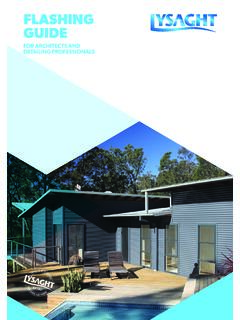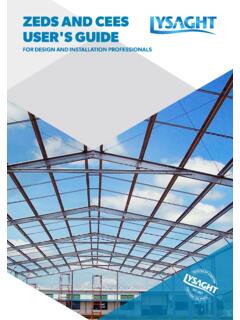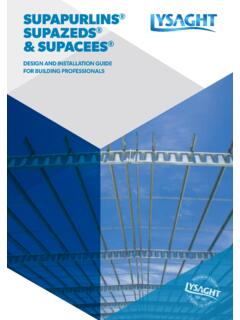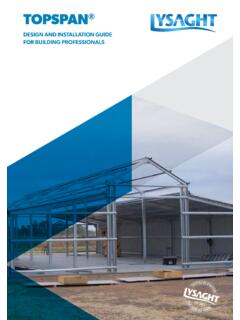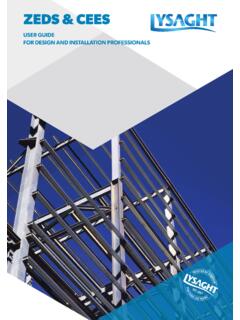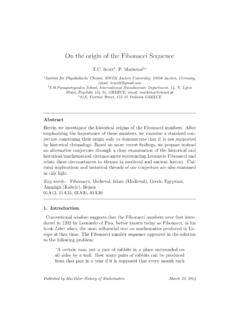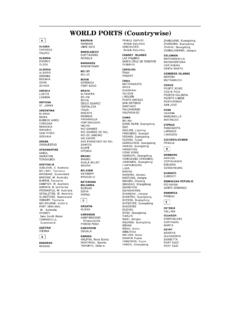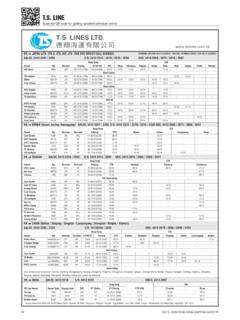Transcription of WIND CLASSIFICATION - Lysaght
1 WIND CLASSIFICATIONDESIGN GUIDEWIND CLASSIFICATION2 SELECTION PROCESS - 5 STEP GUIDEC hoose your wind region based on the dwelling 1. Wind RegionTo determine the wind CLASSIFICATION for your domestic building site you must consider 4 factors: the Region, the Terrain Category, a Shielding Factor and the information is to be used as an approximate guide for residential structures only. This information is based on the Australian Standard AS4055-2012, wind load for housing. For a detailed analysis refer to the Australian Standard approach is only suitable for houses up to 2 storeys high and no wider than 16m and JunctionMt AmyMillstreamMarble BarGreen HeadGeraldtonCarnarvonOnslowCroydonPort HeadlandBroomeDerbyAlice SpringsWyndhamIvanhoeAdelaide RiverKatherineWest MorelandWeipaMcDonnelMoretonCooktownCair nsTownsvilleBowenMackayRockhamptonBundab ergMaryboroughGra onCorindiCoffs HarbourCollinsvilleAthertonEmeraldBilocl aMintoToowoonbaCasinoGlen InnisDunbarHobartREGION ANormal100km50km100kmREGION BIntermediate50kmREGION CTropicalCyclonesREGION DSevereTropicalCyclonesREGION ANormalREGION ANormalREGION CTropicalCyclonesREGION BIntermediateREGIONA - NormalB - Intermediate - 100kmsC - Tropical Cyclones - 50kmsD - Severe Tropical CyclonesWIND CLASSIFICATION3 Determine your terrain category.
2 The terrain category describes the surface roughness of the surrounding area 500m from the housing 1 TC1 Very exposed open terrain with few or no obstructions and enclosed limited sized water surfaces, flat, treeless, poorly grassed plains, or river, canals, lakes and enclosed bays, extending less than 10 km in the wind water surfaces subjected to shoaling waves, near-shore water, large unenclosed bays on seas and oceans, lakes and enclosed bays extending greater than 10km in the wind 2 TC2 Open terrain including grassland with well-scattered obstructions having heights generally from to 5m with no more than two obstructions per hectare, farmland and cleared subdivisions with isolated trees and uncut with a few trees or isolated obstructions. This category is intermediate between TC2 and TC3 and represents the terrain in developing outer urban areas with scattered houses, or large acreage development with fewer than 10 buildings per 3 TC3 Terrain with numerous closely spaced obstructions having heights generally from 3m to 10m.
3 The minimum density of obstructions shall be at least the equivalent of 10 house-size obstructions per hectare, suburban housing, light industrial estates .Step 2. Terrain CategoryTERRAIN CATEGORY TC CATEGORY 1 TC 1 TERRAIN CATEGORY 2 TC 2 WATERTERRAIN CATEGORY TC CATEGORY 3 TC 3 WIND WIND CLASSIFICATION4 Determine your terrain category. The terrain category describes the surface roughness of the surrounding area 500m from the housing SHIELDING FSFull shielding where at least two rows of houses or similar size permanent obstructions surround the house being considered. In Regions A & B, heavily wooded areas within 100m of site provide full shielding. The effects of roads or other open areas with less than 100m measured in any direction shall be ignored. Full shielding is for typical suburban development greater than 10 houses per hectare. The first two rows of houses abutting permanent open areas with a least dimension greater than 100m, such as parklands, large expanses of water and airfields, shall be considered to have either partial shielding or no SHIELDING PSPartially shielded where there are a least houses, trees or sheds per hectare such as acreage type suburban development or wooden parkland.
4 The second row of houses are classified as partially SHIELDING NSNo shielding where there are no permanent obstructions or where there are less than obstructions per hectare, such as the row of houses or single houses. Step 3. Shielding FactorFULL SHIELDING FSWIND THIS HOUSE PARTIAL SHIELDING PSWIND THIS HOUSE NO SHIELDING NSWIND THIS HOUSE WIND CLASSIFICATION5 The topographic CLASSIFICATION is determined by the effect the wind has on the dwelling due to its position on the hill, designated to be bottom of the hill is considered very flat or if the slope is less than a 1 in 20 rise a minimal slope would be classed as T0. The maximum slope is measured at the steepest part of the hill regardless of where the dwelling is positioned. A cliff is a slope of greater than 1 in 3 and has the maximum of T5 at the top. Over the top of the hill the wind pressures drop 4. Topography EffectLocation On Hill (Zone) Maximum SlopesLower ThirdMid ThirdTop ThirdOver TopH<10m10m<H<30m H >30m 1:20 Very FlatT0T0T0T0T0T0 1:20 to 1:10 FlatT0T0T1T1T1T0 1:10 to 1 Small HillT0T1T1T2T2T0 1 to 1:5 Medium HillT0T1T2T2T3T1 1:5 to 1:3 Big HillT0T2T2T3T4T2 1:3 CliffT0T2T3T4T5T3H = height of the hill, ridge or escarpment (m)WIND CLASSIFICATION6 Wind regionTerrain CategoryTopographic : N1~N6 are non-cyclonic wind classes, C1~C4 are cyclonic wind CLASSIFICATION SYSTEM FROM AS4055-2012 WIND LOAD FOR HOUSING AS4055 -2012 sets out 10 wind classes N1~N6 & C1~C4.
5 The CLASSIFICATION is a combination of wind region, terrain category, shielding and topography. By determining the appropriate wind class, the user can use AS4055 and other design aids to design dwelling or parts of dwelling for wind load 5. Wind ClassificationLegend: FS = Full shieldingPS = Partial shieldingNS = No shielding N = Non-cyclonicC = CyclonicN/A = Not Available, refer to : ClassCommon NotationLimit state design gust wind speed (m/s)ServiceabilityUltimateN1W282634N2W3 32640N3W413250N4W503961N5W604774N6W70558 6C1W41C3250C2W50C3961C3W60C4774C4W70C558 6 WIND CLASSIFICATION71) Choose your Wind Region based on your dwelling location. (Section 1)2) Determine the appropriate Terrain Category. (Section 2)3) Select the type of shielding your site has. (Section 3)4) Establish the Topography of your area. (Section 4)EXAMPLES OF THE WIND CLASSIFICATION FOR CITIES AROUND AUSTRALIAP laceRegionTerrain CategoryShieldingTopographyWind ClassCommon Notation1 House in the Suburbs - flatATC3 FST1N1W28BN2W33CC1W41 CDC2W50C2 Sydney in the suburbs - flat - on acreage - on top of a steep hill/cliff at , Hobart, Adelaide & Perth in the suburbs - flat - on top of a hillFST1N1W28 ATC3 NST3N3W414 Brisbane in the suburbs - flat - on top of a steep hillTC3 FST1N2W33 BTC3 NST5N5W605 Hervey Bay.
6 Cairns & Darwin in the suburbs - flat away from the beach - on acreage - , WA in suburbs - , dampier , Carnarvon WA in suburbs - flat - suburbs near enquiries: or call 1800 641 417 Lysaght is a registered trademarks of BlueScope Steel Limited, ABN 16 000 011 058. The Lysaght range of products is exclusively made by or for BlueScope Steel Limited trading as DESCRIPTIONS All descriptions, specifications, illustrations, drawings, data, dimensions and weights contained in this catalogue, all technical literature and websites containing information from Lysaght are approximations only. They are intended by Lysaght to be a general description for information and identification purposes and do not create a sale by description.
7 Lysaght reserves the right at any time to: (a) supply Goods with such minor modifications from its drawings and specifications as it sees fit; and (b) alter specifications shown in its promotional literature to reflect changes made after the date of such publication. DISCLAIMER, WARRANTIES AND LIMITATION OF LIABILITY This publication is intended to be an aid for all trades and professionals involved with specifying and installing Lysaght products and not to be a substitute for professional judgement. Terms and conditions of sale available at local Lysaght sales offices. Except to the extent to which liability may not lawfully be excluded or limited, BlueScope Steel Limited will not be under or incur any liability to you for any direct or indirect loss or damage (including, without limitation, consequential loss or damage such as loss of profit or anticipated profit, loss of use, damage to goodwill and loss due to delay) however caused (including, without limitation, breach of contract, negligence and/or breach of statute), which you may suffer or incur in connection with this publication.
8 Copyright BlueScope Steel Limited 3 May, 2017 LYT0115



